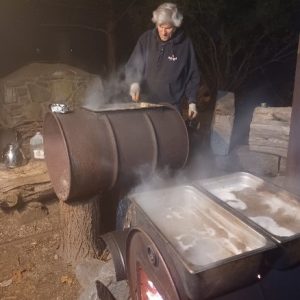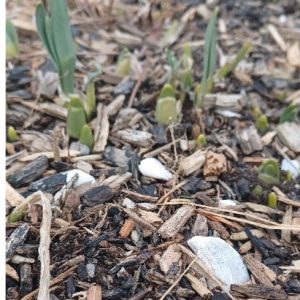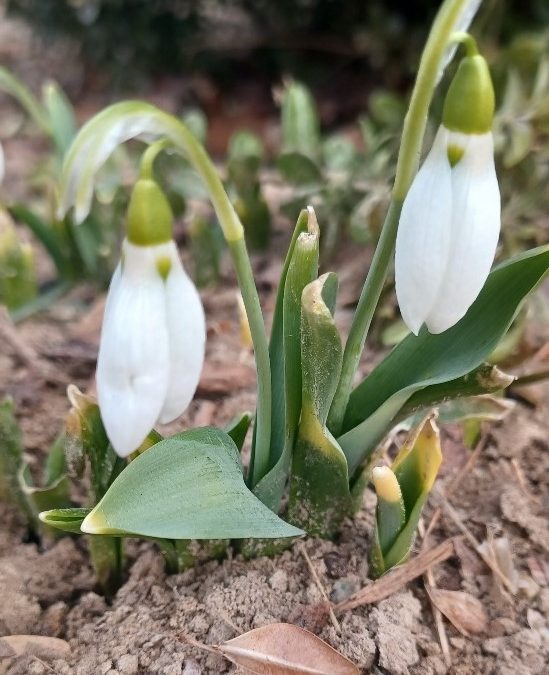by Rev. Racquel Ray
Associate Minister of Congregational Life
The Song of the Snowdrop Fairy
by Cicely Mary Barker (1895-1973)
Deep sleeps the Winter, cold, wet and grey:
Surely all the world is dead; Spring is far away.
Wait! The world shall waken: it is not dead, for lo
The Fair Maids of February stand in the snow!
February is here. The month of transitional days begins with the darkness of January and ends with the promise of spring. It was a dreary January. There were too many cloudy days for our solar panels and our psyche to appreciate any solar gain. Seasonal depression was a real challenge for many of us – even those of us for whom this is not usually an issue. I found this Cicely Mary Barker poem comforting and hopeful. Perhaps you do too?
The Song of the Snowdrop Fairy invited me into the garden. It brought me to an observational walkabout around Ray Farm and our church gardens. And, indeed, the Fair Maids of February are standing in the snow (or in this case frozen soil). There are early signs of spring sprouting around the yard and churchyard. For now, we are in a season of hope and preparation.
February is a busy month for my family. We celebrate Lunar New Year with a traditional meal of long noodles, representing a long life. We include orange slices to represent a sweet life and plenty of rice to represent abundant provision. Having served in the military in several Pacific duty stations, our family celebrates with a mix of pan-Asian cuisine. We remember the past and look forward to the coming year.
representing a long life. We include orange slices to represent a sweet life and plenty of rice to represent abundant provision. Having served in the military in several Pacific duty stations, our family celebrates with a mix of pan-Asian cuisine. We remember the past and look forward to the coming year.
We celebrate St. Valentine’s Day and one of our kids’ birthdays. We tap the maple trees in our backyard and spend a week boiling the abundant sap over a wood fire and a specially made stove. Our homemade maple syrup is buttery and smokey; it is rich and dark and very fresh. It is our tradition to celebrate Shrove Tuesday with pancakes smothered in this sweet ichor. Sometimes we’ll  be lucky enough to have johnny cakes or corn meal cakes from last year’s final corn harvest, dried and ground just for this feast. We create a plan for the garden and draw a picture of what will be planted where. And we order the seeds in hopeful expectation of a bountiful autumn harvest.
be lucky enough to have johnny cakes or corn meal cakes from last year’s final corn harvest, dried and ground just for this feast. We create a plan for the garden and draw a picture of what will be planted where. And we order the seeds in hopeful expectation of a bountiful autumn harvest.
In the gardens, the rhubarb is just beginning to break through the mulch. Bright scarlet crowns can be seen among the greys and browns of winter. We’ll soon be harvesting more than we can eat and the overflow will be sliced into bite sized pieces and frozen for later. I usually make a Christmas morning rhubarb crisp many months from now. It often can be enjoyed as pie during coffee hour and potluck meals. The asparagus will be emerging soon and the yard will be dotted with cheery yellow dandelions and deep purple violets. The dandelion roots can be dried and ground and used as a coffee substitute. Our violets are lovingly picked by small hands and made into posies and a delicate light purple spring tonic tea.
Our violets are lovingly picked by small hands and made into posies and a delicate light purple spring tonic tea.
Lent begins on Wednesday, February 14 this year. We as a family and as a congregation will observe the six weeks of preparation before Easter. As the weeks unfold, so will the gardens. Our gardens at home and at church will remind us that new life is imminent.
Pastor Dale and I will be building a garden in the sanctuary throughout Lent. As the weeks pass, our garden will grow and we’ll learn together about the importance of creating sacred spaces; making physical, virtual, temporal, and spiritual places to observe, acknowledge, and celebrate our relationship with God. We’ll learn how to attend  to our prayer lives and nurture our connection with creation and the Creator. We’ll share in Jesus’ praxis of going away to a quiet spot to pray and sometimes it was as simple as ‘a stone’s throw away’ into the garden.
to our prayer lives and nurture our connection with creation and the Creator. We’ll share in Jesus’ praxis of going away to a quiet spot to pray and sometimes it was as simple as ‘a stone’s throw away’ into the garden.
We’ll build a foundational structure and invite the congregation to join us as we add the elements week by week. Soil, representing the nutrient rich foundation where the roots of our faith can take hold and grow deep into the earth. Seeds, representing new ideas co-created and germinated with God to provide for our needs and share with our neighbors. Rocks, representing the cornerstones and building blocks which set boundaries and add structure to our space. Water, representing the power and provision of God which both washes and nourishes us. We’ll add crosses and a tomb to remind us of The Passion and sacrifice of Jesus which makes a way for new life.
As Holy Week and Easter emerge, so will our gardens. The daffodils outside of my church office get an early start in a sheltered corner and are a harbinger of spring to come. Around the church campus, other clumps of cheerful daffodils, lovingly planted and cared for, will join them in the coming weeks. The pale purple crocus near the labyrinth will blossom. The trees will bud, the forsythia near the kitchen steps will burst with sunny yellow blooms, the pollinator garden will begin to flourish, and our rose hedge will swell with rich greens and coming buds.
Around the church campus, other clumps of cheerful daffodils, lovingly planted and cared for, will join them in the coming weeks. The pale purple crocus near the labyrinth will blossom. The trees will bud, the forsythia near the kitchen steps will burst with sunny yellow blooms, the pollinator garden will begin to flourish, and our rose hedge will swell with rich greens and coming buds.
Where will you find yourself in the coming weeks? Emerging from the dreary grey days of January? Awakening from the frosty hardness of winter? Turning toward the sunshine and the sacred? Looking forward to spring and resurrection? Join us and the snowdrops, the Fair Maids of February, in the journey to new life and new growth in the coming weeks.



